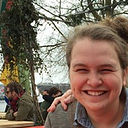Take 17: The Gold Rush
In July of 2015, the BBC released a list of the 100 Greatest American Films, curated by polling critics all over the world. I’m watching them and writing about them as a form of self taught film school. This week… we’re doing number 17, Charlie Chaplin’s The Gold Rush. As always, there will be spoilers.
Charlie Chaplin died almost fifty years ago, and yet remains one of the most recognizable figures in American cinema. The Gold Rush is the highest ranked of the three Chaplin films to make this particular top 100 list and the second highest silent film. I had never seen it before, but it felt vaguely familiar. Chaplin’s tramp character, peeks over the mountain pass — his signature black, disproportionate, silhouette pops in the endless sea of white snow. He’s a penguin waddling through a treacherous desert of risk, unbothered by the bleakness of his surroundings.
The story has little to do with the actual gold rush, which is really only a little bit of gas in the engine to put us in the proper setting. It is mostly a romantic comedy between the Little Fellow and a dancing girl, named Georgia. The humor is often physical clownery, but with a soft maturity added to it. Early in the film we see Big Jim and the Little Fellow munching on one of his boiled boots. Throughout the rest of the movie, his cloth wrapped foot is used to kick along other gags. There were times I was reminded of Arrested Development, especially in the moments where the joke is right in front of you, but as that bit landed, it created a domino effect and all of the action built to an avalanche of cascading setups and punchlines. This comedic tempo which deftly mixed one-two punch sight gags with long simmering set ups is an effective means of manipulating attention and expectations of the viewer.
I took a class in college that was called “Learning to See” and it was as rigorous of an academic experience as you would expect from the course name. I don’t remember much of what we studied, but I did think of the concept of seeing, not sight, as a skill. I often hear people refer to practicing active listening, and I think that Chaplin’s gift is his ability to exercise our vision in much the same way — it is a microcosmic example of how removing stimulation of one sense can amplify another. Without the assistance of dialogue, the viewer must translate the antics on screen. His vaudeville roots are obvious and his unpretentious puppetry is mesmerizing. He dances around with physical humor, manipulating the strings of his co-stars in the effort. That’s not to say he overshadows them, but his flitting around is always the action our eyes track when he’s sharing the screen.
There’s something powerful in being an early adopter of a new artistic medium in that you’re able to harness a tool that has not lost its novelty effect. We, in 2020, are surrounded by stimuli and the real estate of our eyes, our ears, our attention is subject to constant competition. It can be easy to forget how this is a radical shift for humanity occurring rapidly over a relatively short amount of time. I remember listening to an enlightening explanation of how transformative it was for churches to start displaying ornate oil paintings of religious scenes. Given that most of the population couldn’t read and access to printed materials was limited, church might be the only opportunity for most common people to hear an oral story by a vibrant personality and gaze upon a work that stirred emotions and told a dramatic story. Chaplin may have served a similar role in the lives of moviegoers in the early 1920s who would no doubt still be adjusting to the dancing images, with some dramatic special effects. While Chaplin’s roots as a theater star are evident, there are some impressive effects peppered throughout the film: the avalanche that kills Black Larsen or the image of the house teetering on the edge of a cliff, for instance. Chaplin succeeded in extracting the most endearing artifacts of vaudeville and enhanced them by leveraging the capabilities of a budding art form.
